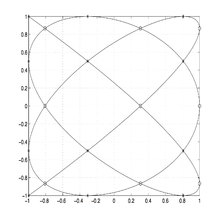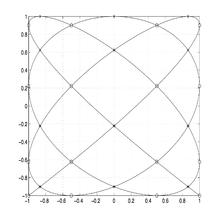Padua points
In polynomial interpolation of two variables, the Padua points are the first known example (and up to now the only one) of a unisolvent point set (that is, the interpolating polynomial is unique) with minimal growth of their Lebesgue constant, proven to be O(log2 n) .[1] Their name is due to the University of Padua, where they were originally discovered.[2]
The points are defined in the domain . It is possible to use the points with four orientations, obtained with subsequent 90-degree rotations: this way we get four different families of Padua points.
The four families


We can see the Padua point as a "sampling" of a parametric curve, called generating curve, which is slightly different for each of the four families, so that the points for interpolation degree and family can be defined as
Actually, the Padua points lie exactly on the self-intersections of the curve, and on the intersections of the curve with the boundaries of the square . The cardinality of the set is . Moreover, for each family of Padua points, two points lie on consecutive vertices of the square , points lie on the edges of the square, and the remaining points lie on the self-intersections of the generating curve inside the square.[3][4]
The four generating curves are closed parametric curves in the interval , and are a special case of Lissajous curves.
The first family
The generating curve of Padua points of the first family is
If we sample it as written above, we have:
where when is even or odd but is even, if and are both odd
with
From this follows that the Padua points of first family will have two vertices on the bottom if is even, or on the left if is odd.
The second family
The generating curve of Padua points of the second family is
which leads to have vertices on the left if is even and on the bottom if is odd.
The third family
The generating curve of Padua points of the third family is
which leads to have vertices on the top if is even and on the right if is odd.
The fourth family
The generating curve of Padua points of the fourth family is
which leads to have vertices on the right if is even and on the top if is odd.
The interpolation formula
The explicit representation of their fundamental Lagrange polynomial is based on the reproducing kernel , and , of the space equipped with the inner product
defined by
with representing the normalized Chebyshev polynomial of degree (that is, , where is the classical Chebyshev polynomial of first kind of degree ).[3] For the four families of Padua points, which we may denote by , , the interpolation formula of order of the function on the generic target point is then
where is the fundamental Lagrange polynomial
The weights are defined as
References
- ↑ L. Bos, M. Caliari; M. Vianello, S. De Marchi,; Xu, Y.; Vianello, M; Xu, Y (2006), "Bivariate Lagrange interpolation at the Padua points: the generating curve approach", J. Approx. Theory, 143 (1): 15–25, doi:10.1016/j.jat.2006.03.008
- ↑ M. Caliari, S. De Marchi; Vianello, M.; Vianello, M (2005), "Bivariate polynomial interpolation at new nodal sets", Appl. Math. Comput., 165 (2): 261–274, doi:10.1016/j.amc.2004.07.001
- 1 2 M. Caliari, S. De Marchi; Vianello, M. (2008), "Algorithm 886: Padua2D: Lagrange interpolation at Padua points on bivariate domains", ACM T. Math. Software, 35 (3)
- ↑ S. De Marchi, L. Bos; Y. Xu, M. Vianello; Vianello, Marco; Xu, Yuan (2007), "Bivariate Lagrange interpolation at the Padua points: the ideal theory approach", Numerische Mathematik, 108 (1): 43–57, doi:10.1007/s00211-007-0112-z